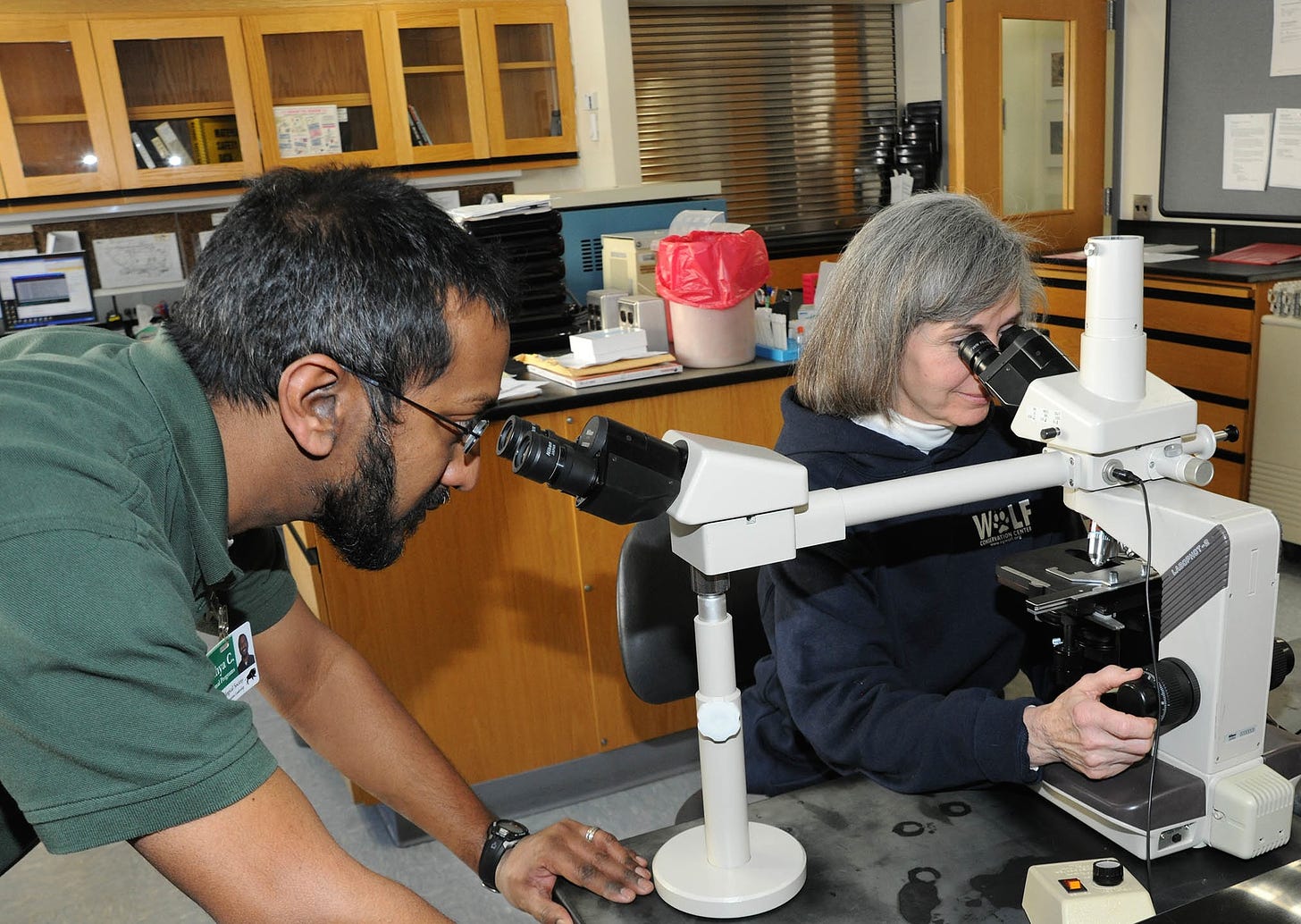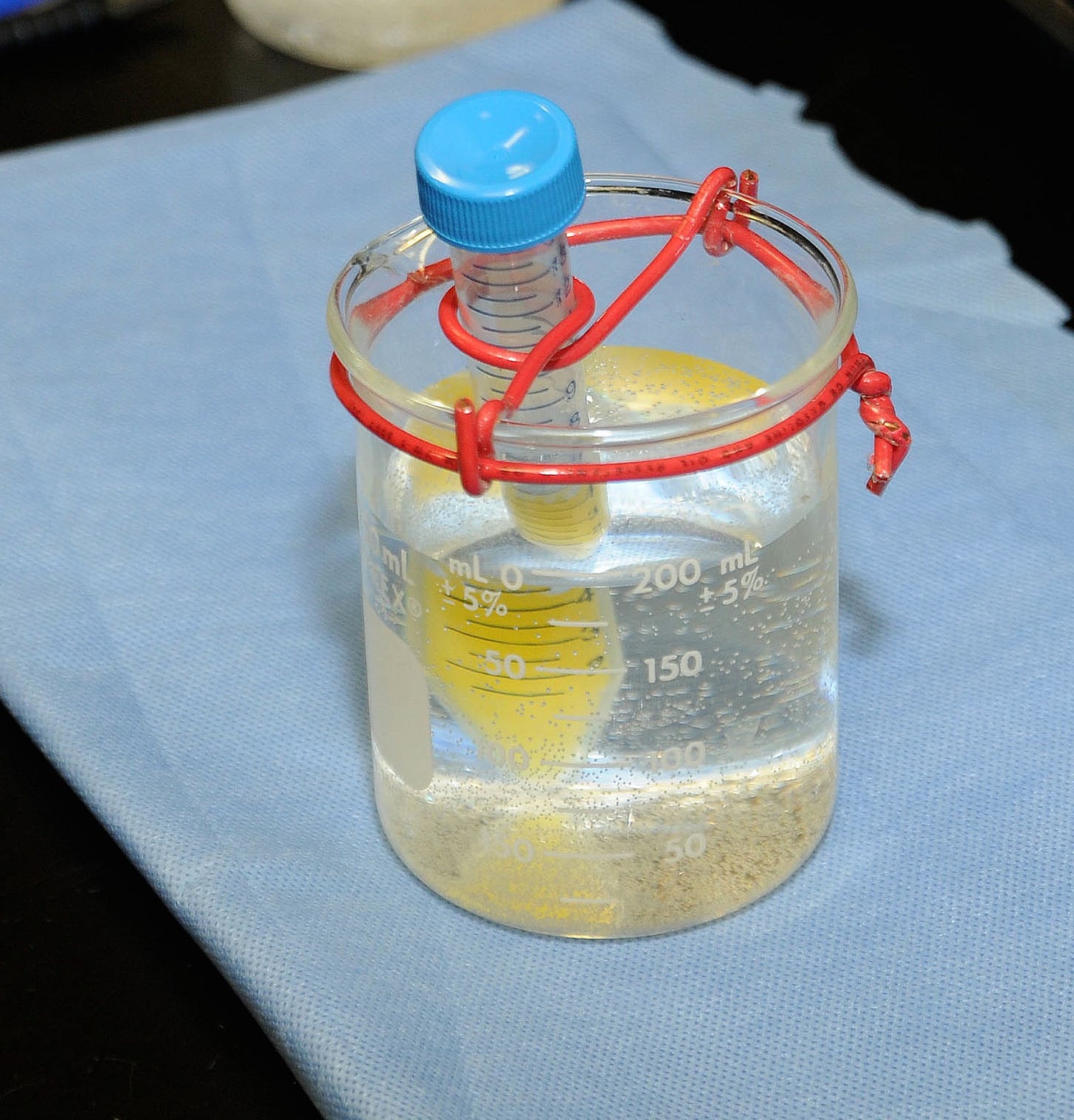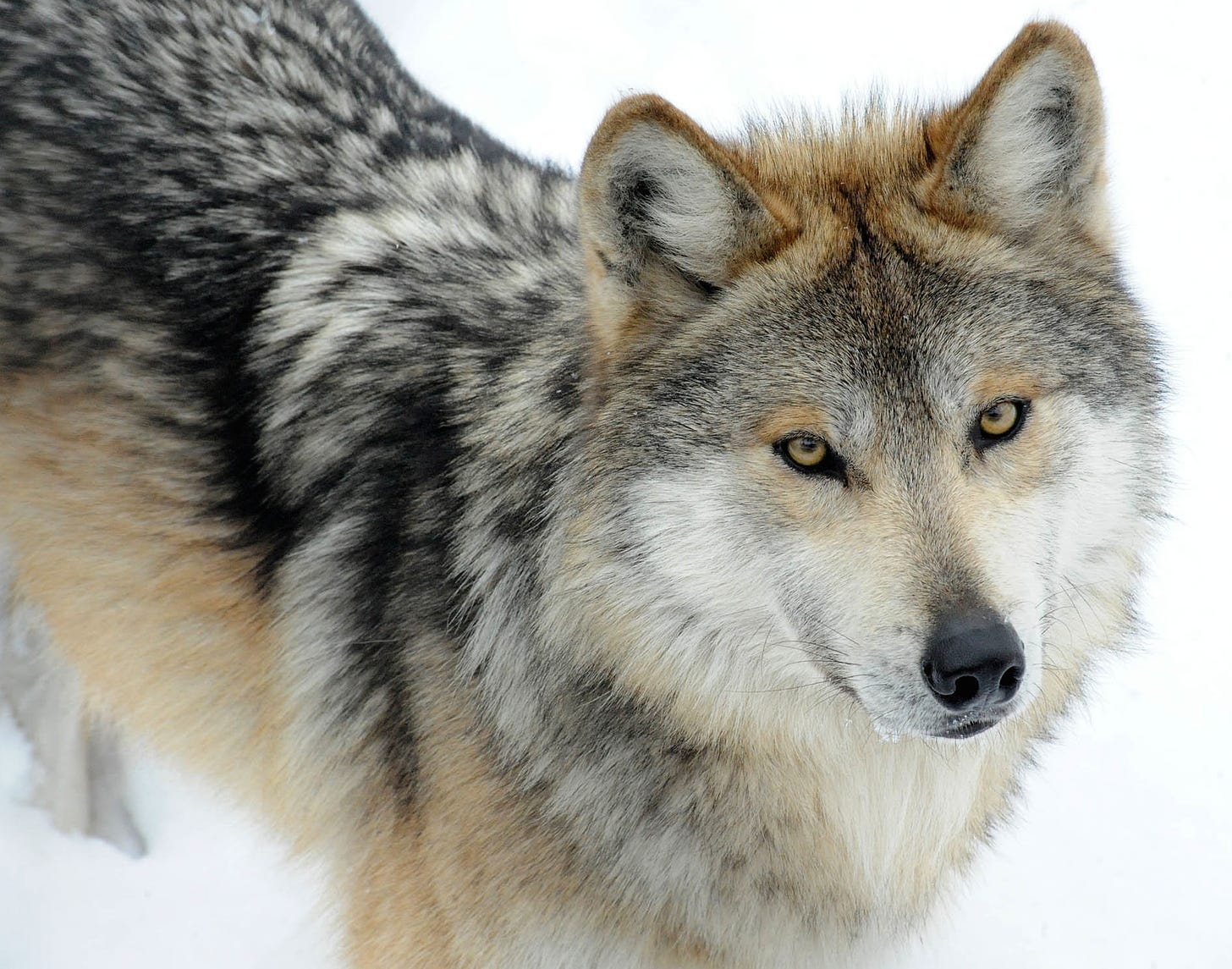Sperm Banking Revives Endangered Mexican Wolf
USFWS & AZA Accredited Zoos Continue Mexican Wolf Recovery Efforts
By Jordan Schaul | National Geographic | April 5, 2014
Earlier this week, the USFWS announced that a pregnant, captive-born, female Mexican wolf reared at Chicago’s Brookfield Zoo will be released next week into the Blue Range Wolf Recovery Area of Arizona as a part of the Mexican wolf recovery effort in the United States. F1126, known as “Ernesta” to zoo staff, has been...
One of the male Mexican gray wolves at Brookfield Zoo. They can be seen at the Regenstein Wolf Woods exhibit. (Photo credit: Jim Schulz/Chicago Zoological Society)
Earlier this week, the USFWS announced that a pregnant, captive-born, female Mexican wolf reared at Chicago’s Brookfield Zoo will be released next week into the Blue Range Wolf Recovery Area of Arizona as a part of the Mexican wolf recovery effort in the United States.
F1126, known as “Ernesta” to zoo staff, has been paired with a male (M1249) who was captured during an annual survey of the wolf population. Another pair was already released into Apache National Forest this month.
“We anticipate the release of these two pregnant females from captivity will have a higher chance of success because they are paired with males that already have extensive wild experience,” said Benjamin Tuggle, the USFWS’s Southwest Regional Director. “The genetic value of the two females will help us as we move toward establishing a more genetically robust population of wild wolves.”
Besides supplying reintroduction candidates, zoos have been instrumental in the restoration effort for the endangered subspecies through genetic management of the captive gene pool. A collaborative effort between St. Louis and Brookfield zoos has also demonstrated that assisted breeding technology is closer to becoming a reality for frequent use in the wolf conservation effort. Artificial insemination (AI) can be a tool of great value once the genetic management of the captive wolf population is enhanced with the help of gamete banking—the storage of semen and ova from living or deceased wolves.
New developments in cryonics, specifically the banking of vitrified oocytes, may be a game-changer in the conservation of genetic diversity for endangered species. The technique ultimately eliminates the reliance on existing embryo cryopreservation and subsequent transfer technology.
Vitrification of oocytes, which is unprecedented for an endangered species recovery program, refers to the complete removal of lethal ice crystals within the oocyte. Vitrification differs from standard cryopreservation in that the oocytes are moved through solutions that pull the water out of the oocyte to prevent ice formation. Along with the preservation of semen, the vitrification of oocytes will serve to optimize genetic management of the captive population.

Dr. Cheryl Asa, the director of research at the St. Louis Zoo, indicated that semen banking is just as integral to the genetic management of Mexican wolves as egg cell banking because they can match ova with sperm from more males than those that are living. Dr. Asa said, ”Currently our focus is on banking genes. Although animals will age and eventually die, their genes will still be available.” So for now, she said, “Components of cryopreservation, from freezing protocols to post-thaw analysis of sperm and egg quality, will be important to assisted breeding applications (e.g. artificial insemination).”
The St. Louis Zoo has maintained a frozen semen bank under the auspices of the USFWS Mexican wolf recovery program since 1991. St. Louis Zoo is one of the few sophisticated captive wildlife facilities in the world with the capacity to bank genes and develops complementary assisted reproduction technologies. Advances in reproductive physiology and theriogenology are increasingly being used in the ‘sorta situ’ (ex-situ and in-situ) approach to conservation. They offer more than just a means to artificially propagate founder stock for field conservation programs.
As far as gamete banking is concerned, zoos can pinpoint specific genes that will benefit the reintroduction program. Joan Daniels, Associate Curator at the Brookfield Zoo said, “In addition, these techniques can permit the selective breeding of individuals representing specific genetic lineages.” She added that they can also use cryogenics to preserve gametes for future reproduction efforts if they are not needed for current breeding plans. Zoo populations also provide backup stock in the event that a reintroduced individual becomes a casualty.
As a result, the zoos involved with the Mexican Wolf Species Survival Plan have made it logistically possible and feasible to continually augment reintroduction populations with genetically sound and redundant individuals, fine-tuning science to make recovery efforts more efficient and more resilient.

From the type of semen collection method (i.e. manual or electroejaculation) to the storage method (i.e. fresh, chilled, or frozen) to picking the right donor, to choosing surgical or nonsurgical insemination procedures, many options exist in terms of biotechniques to choose from. Of course, these living institutions are committed to animal welfare as much as their mission is to conserve. So they practice the least invasive techniques, and often without the risk of surgery when it comes to the genetic management of captive wildlife.
Although gray wolves were once the most widespread mammals on the planet, the extant population now occurs in one-third of its historic range, including three states in the southwestern U.S. where it was once extirpated.
Thanks to the development of reproductive strategies such as sperm banking, along with a highly coordinated management of the living population, the Mexican wolf—one of 27 subspecies of gray wolves—is making an impressive comeback. Mexican wolves have been and will continue to be released in designated U.S. recovery zones in the Apache and Gila National Forests of New Mexico, through a rigorous selection and acclimation process.
This subspecies has been functionally extinct (extinct in the wild) in the United States for many decades. It was nearly extirpated in Mexico, but occasional sightings in the 1970s confirmed that the wolf was still free-ranging across the Mexican border. Its U.S. range included—Arizona, Texas, and New Mexico—and new research suggests the subspecies may have occurred further north.
But it is the captive management and captive population, now comprised of 300 wolves in 45 U.S. and Mexican facilities that have saved the endangered canid from absolute extinction. In fact, conservation breeding of Mexican wolves, which are also the smallest and rarest subspecies of grey wolf, has been an integral part of the restoration program since its inception in the late 1970s.
Specifically, a species survival program was established in 1977 for the subspecies recovery effort. This bi-national breeding program was launched with the capture of the entire wild population and it has undoubtedly saved the Mexican wolf.
Jump ahead to today. Nearly 40 years have passed since the founding stock of five wild individuals was first placed in captivity. On March 29, 1998, almost 16 years ago exactly, the first 11 captive-reared wolves were released into the Blue Range Wolf Recovery Area, which includes the aforementioned National Forests in portions that extend through parts of New Mexico and Arizona.
Last year marked the third consecutive year in a row that the Mexican Wolf Recovery Program saw a 10 percent or greater increase in the population size of this subspecies of grey wolf, which is comprised of 15 packs. Fixed-wing aircraft and ground census work confirmed this increase for an extant population of wild-born wolves. It is significant that these wolves are wild-born. The founder stock of captive wolves has perished since the inception of the recovery program. However, their offspring and that of subsequent generations of Mexican wolves, all born in the wild, continue to flourish and produce their own litters. This is a testament to the success of the reintroduction program and is suggestive of just how genetically robust the wolf population has become.
In the future, zoos will be able to transport semen instead of their resident wolves and coordinate “breeding” activities between institutions through the AZA’s nationwide Mexican Wolf Species Survival Program and even internationally.
According to Joan Daniels, a curator at the Brookfield Zoo who has oversight over the institution’s Mexican wolf management program, “Having future capabilities to use advanced reproductive procedures with wolves such as artificial insemination will greatly enhance the ability to manage zoo populations. Individual wolves might not need to be moved from one zoo to another for breeding if genetic material could be exchanged instead. Wolves are highly monogamous and socially bonded in captive packs, so not having to disrupt the social groupings to manage the genetics would be of great benefit.” As mentioned, semen can also be stored and utilized from animals well after they have expired which will allow for the preservation of genetic lineages until space is available to allow for selective reproduction.
As a note, the Regenstein Wolf Woods, which includes the Mexican wolf exhibit at the Brookfield Zoo, includes “design implementations to cultivate natural behaviors” conducive to animals being released into the wild. These include the following husbandry practices and enclosure design features:
Wolves socialize only with each other. Keepers do not interact directly with wolves.
Wolves receive native prey species such as elk hide, bison meat, and whole prey items.
Climbing logs, a pool, heated rocks, and loose dirt encourage natural behaviors like playing, lounging, and digging.
Buildings blend in with the natural surroundings so that the wolves don’t associate manmade structures with shelter or food.
“We are committed to the highest level of animal care, and Regenstein Wolf Woods ensures that wolves participating in the release program will be successful in their transition into the wild,” Daniels said.
In 2012, I reported on the first attempted release of Ernesta. I also reported on the advances in clinical care and study of Mexican wolves, made possible by the Brookfield Zoo’s sophisticated diagnostic imaging suite in this earlier piece.
Dr. Jordan Schaul is an American zoologist, conservationist, journalist and animal trainer based in Los Angeles, California. He is a regular contributor to Nat Geo News Watch. For more of his posts, please visit his profile page on this website.
ABOUT NATIONAL GEOGRAPHIC SOCIETY
The National Geographic Society is a global nonprofit organization that uses the power of science, exploration, education and storytelling to illuminate and protect the wonder of our world. Since 1888, National Geographic has pushed the boundaries of exploration, investing in bold people and transformative ideas, providing more than 14,000 grants for work across all seven continents, reaching 3 million students each year through education offerings, and engaging audiences around the globe through signature experiences, stories and content. To learn more, visit www.nationalgeographic.org or follow us on Instagram, Twitter and Facebook.
MEET THE AUTHOR
Jordan Carlton Schaul With training in wildlife ecology, conservation medicine and comparative psychology, Dr. Schaul's contributions to Nat Geo Voices have covered a range of environmental and social topics. He draws particular attention to the plight of imperiled species highlighting issues at the juncture or nexus of sorta situ wildlife conservation and applied animal welfare. Sorta situ conservation practices are comprised of scientific management and stewardship of animal populations ex situ (in captivity / 'in human care') and in situ (free-ranging / 'in nature'). He also has a background in behavior management and training of companion animals and captive wildlife, as well as conservation marketing and digital publicity. Jordan has shared interviews with colleagues and public figures, as well as editorial news content. In addition, he has posted narratives describing his own work, which include the following examples: • Restoration of wood bison to the Interior of Alaska while (While Animal Curator at Alaska Wildlife Conservation Center and courtesy professor at the University of Alaska) • Rehabilitation of orphaned sloth bears exploited for tourists in South Asia (While executive consultant 'in-residence' at the Agra Bear Rescue Center managed by Wildlife SOS) • Censusing small wild cat (e.g. ocelot and margay) populations in the montane cloud forests of Costa Rica for popular publications with 'The Cat Whisperer' Mieshelle Nagelschneider • Evaluating the impact of ecotourism on marine mammal population stability and welfare off the coast of Mexico's Sea of Cortez (With Boston University's marine science program) Jordan was a director on boards of non-profit wildlife conservation organizations serving nations in Africa, North and South America and Southeast Asia. He is also a consultant to a human-wildlife conflict mitigation organization in the Pacific Northwest. Following animal curatorships in Alaska and California, he served as a charter board member of a zoo advocacy and outreach organization and later as its executive director. Jordan was a member of the Communication and Education Commission of the International Union for the Conservation of Nature (CEC-IUCN) and the Bear Specialist Group of the IUCN Species Survival Commission (BSG-SSC-IUCN). He has served on the advisory council of the National Wildlife Humane Society and in service to the Bear Taxon Advisory Group of the Association of Zoos and Aquariums (AZA Bear TAG). In addition he was an ex officio member of council of the International Association for Bear Research and Management.



